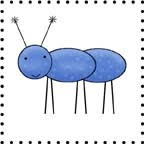Monday, June 7, 2010
We've Moved...
Come find me here: http://lpmkendrahalterman.blogspot.com/!
Monday, April 5, 2010
Now Registering for Fall!
- See the column to the right hand side for potential class times.
- There are 3 time slots listed on the registration form, but there will only be one or two 2nd year classes. The actual class times will be determined by the first choices of those who get their forms turned in soonest. If you have a difficult schedule, please turn in your form right away, and let me know your conflicts.
- The number of first year classes will depend on interest.
- See the sidebar for tuition and registration fees. Tuition is slightly higher for 2nd year as classes are longer (50 mins.).
- You have the opportunity to save a little money! Turn in your completed registration form and materials fee by the evening of our recital (April 22), and I will waive your $15 registration fee.
- For each student you refer to sign up for the program, I will deduct $15 from your first months' tuition. Just have the student note that you referred them to the program on their registration form.
Recital Time!
This means my Thursday PM class for that week, will be moved to Tuesday @ 6:15pm (lesson 15)
You are welcome to bring family (grandparents, etc.), and encouraged to bring friends who are interested in learning more about the program that night. Please, email me (kendrascreations@gmail.com) and let me know, if there will be more than your immediate family there, so I can be prepared with seating and refreshments.
Although this recital is fairly informal, I would encourage your students to dress nicely, as it will help prepare them for performances to come.
This should be a special time for the students. Certificates will be handed out, and they will feel great about how far they have come this year. Please plan to attend! If for any reason, your student cannot come that night, please let me know a.s.a.p.
Thursday, March 11, 2010
News and Lesson 9 (Blue Bugs)
 First of all, I wanted to let you know about a cool new feature on the Let's Play Music Website!
First of all, I wanted to let you know about a cool new feature on the Let's Play Music Website!Monday, March 8, 2010
Let's Play Music on TV
Shelle (the creator of the program), and Jenny (my trainer) were on TV today. You can get some fun glimpses into what is coming up in future semesters.
Wednesday, March 3, 2010
Lesson 8-- Blue Bugs
During class we looked at the notation for The Dinosaur Song and saw that it was all skips and babysteps. Your child should be ready to color the skips and steps for the homework assignment, and have fun singing as the notes go up.
We also did B-I-N-G-O, for the first time. It is a fun one to help them practice clapping their rhythms. And speaking of rhythms, as you work with your students on their bug flashcards, see if you can get them to clap the appropriate rhythm with out saying the word. Sometimes, the kids say "but-ter-fly," the right way, but clap a steady eighth note rhythm at the same time. While keeping rhythm is a great skill (and one we will practice more with our jungle animals), we want them to feel each rhythm, and not just hear it. You can make it a game: "Can you clap a caterpillar for me with out saying a word?", "How about a grasshopper?", etc.
Tuesday, February 23, 2010
Lessons 6 & 7

In lesson 6, we had fun singing about El Gallo (the old rooster…he’s dead and won’t be saying cock-a-doodle anymore). It’s interesting to hear how children speaking other languages interpret the sounds that animals make! To learn the words to this song, I recommend you look up the lyrics in your parent manual. Each song is back there. When you come to class, it may be helpful to follow along if you don't know the songs as well as your students do.
We also learned to match the term MAJOR to songs that sound happy and MINOR to those that are sad, tired, or mysterious. Help them remember these terms, and see if they can identify which songs are major and minor as you listen to music.
While singing the Jungle Rhythms, encourage your child to use his voice along with his hand actions. This adds another dimension and will help him to stay on his rhythm. We tried keeping the elephant rhythm while I did the lion. See if you can help your child stay on elephant while listening to all the other animals on the CD. This may take some practice.
LESSON 7
When we put each bell on a line (or space) on the giant staff, it helps introduce the idea that each bell (note) has a representative line or space that corresponds with it. Next year each key on the keyboard will have a line or space that corresponds with it...it’s an easy mental transition to make.
Take this idea a few levels forward and you have...the song How to Skip! The music is printed in the parent’s manual for you. Not all students will master this song, but if your child enjoys playing the short melodies, she’ll probably like to work through this one, and she’ll feel so accomplished when she learns to play a REAL song! Most of the melody can be figured out note-by-note (is it a step up or down? A skip up or down?). On those occasions where there is a leap, the solfeg is written below the music to help your child find the right bell.
The Dinosaur Song is one that everyone probably WILL master – and a great example of skips and babysteps. We’ll see it many times in the next few weeks.
If your child finds writing small notes to be challenging in this week’s homework, feel free to help as needed. You can also copy the page or draw 5 quick lines of your own so you can repeat activities like this as many times as you like for practice!
I suggested you use your bug flashcards for a memory/matching game. This is a fun way to reinforce what we are doing in class. btw, I found a set of flashcards at the LDS church around the corner, on Sunday. If you are missing yours, let me know.





